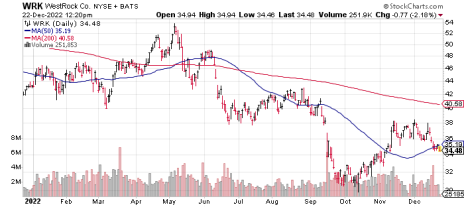Amazon (AMZN) ships hundreds of millions of packages every month. Most of them are cardboard boxes. Does that mean investing in cardboard stocks is a good idea? Let’s talk about it.
Say what you will about Jeff Bezos, Amazon’s business continues to grow every year. While other businesses floundered during the pandemic, Amazon flourished. They are arguably the most diversified company in America, having revolutionized the way people shop, launched a video streaming service that rivals Netflix, created a profitable cloud computing wing, etc. During the pandemic, they added 500,000 full- and part-time jobs, although they are expected to lay off as many as 20,000 employees in the coming months. However, AMZN stock is down more than 50% in this year’s bear market for growth stocks, and tech stocks in particular.
If you’re thinking about all the cardboard boxes that arrive on your doorstep every week (and tend to pile up around the holidays) and now you want to invest in cardboard stocks, you can start by looking at the shippers; UPS (UPS) and FedEx (FDX) are worth looking at.
[text_ad]
But everyone knows about UPS and FedEx, so there’s no opportunity there to beat the crowd. And I don’t like to invest with the crowd. Instead, I prefer to invest in less-famous stocks, because they have more upside potential. As people become aware of the companies’ growth stories, the additional buying power tends to push the stocks up, making it a low-risk investing opportunity.
So today I want to tell you about a major player in the cardboard box business, but most people don’t know its name.
Cardboard Stocks Investing with a Big Cardboard Box Merger
The story starts with a big merger.
A company based in Georgia merged with a company based in Virginia to create a company with billions in revenues and thousands of employees in more than 30 countries. Since then, thanks in part to Amazon, revenues at the company (let’s call it Company X) have grown, and the future looks bright—for investors who can see it. With all the focus on Amazon, investors don’t tend to think much about the company that produces all those boxes that go out for shipping.
And it’s not only Amazon’s cardboard boxes that are driving the business; it’s also pizza boxes, six-pack holders for beer and wine, cardboard point-of-sale displays, paper bags, and packaging for personal care and health care products.
In the personal care division, for example, Company X has a group dedicated to designing sprayers for perfumes and other fragrances. Men like differently shaped bottles than women, and older users favor different features than younger users. And the research the company has done enables it to advise fragrance companies on design.
And then there’s packaging for medicine, where the job is much more complicated than simply containing the medication. The company’s best containers help to increase compliance—also known as adherence—so that patients take their medications as prescribed.
This package, for example, uses a tiny microprocessor to not only track when a patient removes the medication but also to record how the patient is feeling at the time.
All told, it’s an impressive product mix, bound to grow as the U.S. economy grows. Plus, there’s great potential for growth outside the U.S. As I mentioned earlier, Company X has operations in 30+ countries. A few years ago, it entered into a joint venture with a Mexican company that netted part ownership of three corrugated packaging facilities, and then invested in a Brazilian box plant.
There’s a Good Dividend Yield, Too
Also, there’s a bonus! The company pays a dividend.
Company X came public in 2015 at 60 and the stock then lost half its value over the following seven months—not a good start. It quickly recovered, reaching as high as 70 in early 2018, before again crashing back to earth, this time in a more drawn-out, painful fashion. From that January 2018 top to the May 2020 bottom at 24, the stock lost two-thirds of its value. The stock subsequently bounced back during the pandemic recovery, retreated with the broad markets in 2022, and looks to have put in a bottom in October. It’s up more than 11% since.
So who is it?
WestRock Company (WRK)
WestRock Company is a leading North American integrated manufacturer of packaging and containers, with a 53% industry market share. WestRock has hundreds of business locations in 30 countries, serving consumer and corrugated markets. We first recommended them back in 2017 as a low-risk investing opportunity in our Cabot Stock of the Week portfolio. A series of higher highs and higher lows would mark a reversal of the recent trend and signal a potential entry point.
What is Cabot Stock of the Week?
Every week, Chief Analyst, Chris Preston, surveys the stocks recommended by seven Cabot advisories—growth stocks, value stocks, large-cap stocks, small-cap stocks, momentum stocks and foreign stocks—and selects one to recommend to Cabot Stock of the Week readers. Portfolio positions are reassessed each week and rated a Buy, Sell or Hold depending on the position’s momentum and prospects. It’s a great way to get curated access to some of Cabot’s best advisories.
To subscribe, click here.
Are you invested in cardboard stocks? Will you after reading this article?
[author_ad]
*This post was first published in 2017 and is periodically updated to reflect current market conditions.

